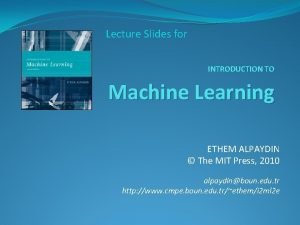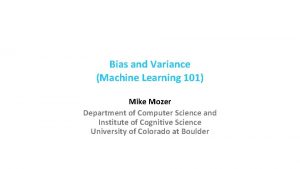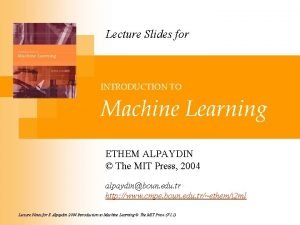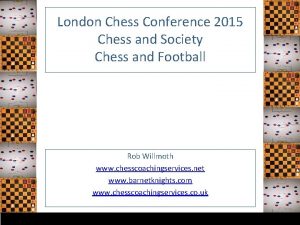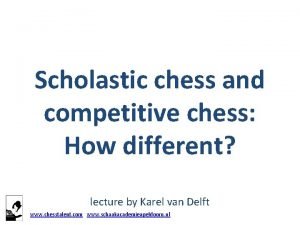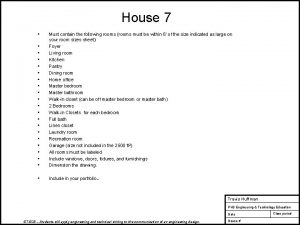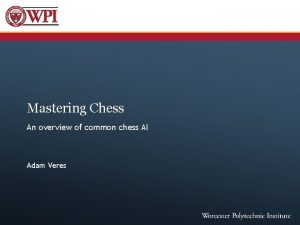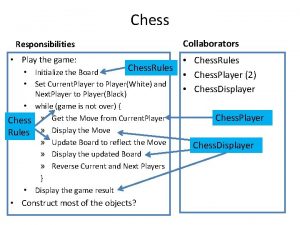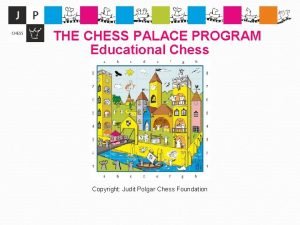Chess Chinese Rooms and Learning Introduction to Machine


















- Slides: 18

Chess, Chinese Rooms, and Learning Introduction to Machine Learning Kamal Aboul-Hosn Cornell University

Chess Computers play well, but not overwhelmingly Even a computer cannot remember all the possible chess games 1080 40 -move chess games! Would take 40 billion years to make one move

Kasparov vs. Deep Blue Garry Kasparov - World chess champion Deep Blue - Supercomputer designed by IBM 256 special processors Analyzed 200, 000 boards per second Deep Blue beat Garry Kasparov in 1997

The Present 2003 match - Kasparov and Deep Junior Runs on a network of desktop PCs Only sees 3 million moves per second Plays “smart chess” like people Match ended in tie

The Future “I think for a while, we'll be having this sort of lead in these matches. But eventually, I believe one day, we'll be reduced to fighting for one single win [against a computer]. In my view, in 10 years' time, the best human player could beat a machine one single game on our best day. ” --Garry Kasparov, to CNN

Was Deep Blue Thinking? NO! Does not understand chess Just looked at a bunch of boards and chose -- programmed by people Can’t do anything but play chess

Was Deep Blue Thinking? YES! Understands as well as humans do Acted like a person -- used memory to chose best move. . . the computer just has a better memory Does “thinking” have to mean “thinking like a human? ”

Strong AI Many definitions: Designing computer programs that reason and solve problems in humanlike or non-human-like ways Weizenbaum: "nothing less than to build a machine on the model of man, a robot that is to have its childhood, to learn language as a child does, to gain its knowledge of the world by sensing the world through its own organs, and ultimately to contemplate the whole domain of human thought"

Chinese Room Argument Developed by John R. Searle in 1980 A person is in a room with a giant rule book Through one slot come in Chinese symbols Constructs new symbols from input and rules Sends output through another slot

Chinese Room Argument Person does not actually understand Chinese One sitting outside the room thinks the person knows Chinese A computer is such a system and therefore cannot “think” “Close study, I believe, reveals the Chinese room to be so logically and scientifically flawed that one of the principle questions [is, ] How have so many been snowed so much by so little? ” Larry Steven Hauser

Claims vs. Reality A computer may claim to be conscious, may perform tasks as well as humans, and may convince humans that it is conscious Are these enough to make it conscious?

Definition of Life A living organism must: Use energy Respond to its surroundings Reproduce Grow & develop Can a computer do these things?

Reinforcement Learning Basic idea: Better decisions yield better rewards When a computer makes a decision, tell it how well it did Situation may inherently gives feedback In complex environments, may be only way computer learns to perform well

Consider Training a Dog How do you teach a dog to sit? At the start a dog has no information Pointing and saying “sit” has no inherent meaning to the dog Learns to do what you want via treats when action is correct/scolding when does something wrong

Neural Networks Base learning and processing on the brain First created by Warren Mc. Culloch and Walter Pits in 1943 Advantages Learns based on any set of input Massively parallel Systems exist in many languages

What’s a Neural Network? A collection of computational units, each w/ weight “how important is this unit? ” activation function & threshold - when does the “neuron” fire? inputs f()

Multi-Layer Network Inputs Output units 1 or more hidden layers No cycles

Examples http: //www. bkgm. com/motif/go. html http: //www. geocities. com/chen_levkovich/t ictactoe. html
 Chinese chess with friends
Chinese chess with friends Anglo chinese school primary
Anglo chinese school primary Inductive and analytical learning
Inductive and analytical learning Inductive learning
Inductive learning Lazy learners vs eager learner
Lazy learners vs eager learner Data mining azure
Data mining azure Concept learning task in machine learning
Concept learning task in machine learning Analytical learning in machine learning
Analytical learning in machine learning Pac learning model in machine learning
Pac learning model in machine learning Machine learning t mitchell
Machine learning t mitchell Instance based learning in machine learning
Instance based learning in machine learning Inductive learning machine learning
Inductive learning machine learning First order rule learning in machine learning
First order rule learning in machine learning Cmu machine learning
Cmu machine learning Ethem alpaydin
Ethem alpaydin Machine learning andrew ng
Machine learning andrew ng Introduction to machine learning andrew ng
Introduction to machine learning andrew ng High bias low variance introduction to machine learning
High bias low variance introduction to machine learning Introduction to machine learning ethem alpaydin
Introduction to machine learning ethem alpaydin














